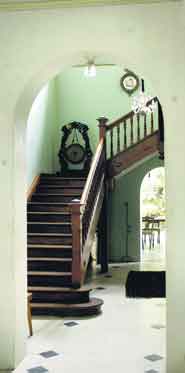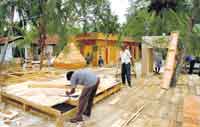|
|
||||||||||||
|
Walk through Water From Ginthupitiya to Flower Road to Bolgoda Lake, Ruhanie Perera discovers the locations behind the scenes of Deepa Mehta’s latest film water The courtyard was completely changed. Where there were once walls of stark whites and greys, there are cheerful yellow pillars. Bright yellow flowers and bursts of green filled up the space that not so long ago was a paved courtyard where a group of women gathered to pray or break fast. On the clothesline, the simple white cloth representing a life of self-denial was now replaced with brightly coloured clothes of all shapes and sizes. The corridors of Spartan living are now chock-a-block with furniture needed for day-to-day living. The stillness of death is replaced with the chaos of life.
I find myself walking through Sri Lanka, 2006, meeting smiling faces and captivating storytellers, but before me plays the story of India, 1938 as I stand in the house which featured in the film Water as the house of widows. Deepa Mehta’s Water, which concludes her elemental trilogy, was the second largest grossing picture in Canada when it opened in November 2005 and was as successful when it opened in the US in April this year. It has thus far been awarded ‘Best Picture’ at the Bangkok International Film Festival Golden Kinnaree Awards, with hopes of many more successes to come. Now showing in Colombo and due to be released in India, it is also the film that just as easily may not have been made.
Filming Water in Sri Lanka began in 2004 after initial attempts at filming in Varanasi seven years ago were stalled on the first day of shooting when the Vishwa Hindu Parishad and the Rashtriya Swayamsevak Sangh destroyed the sets and threatened the film maker, making it impossible to continue to work in Varanasi. The project was closed after the first day of filming; after which began the search for alternative locations within or outside India, and until two years ago when Chandran Rutnam of Film Location Services convinced her that building Varanasi in Sri Lanka was a distinct possibility, Mehta’s dream seemed as if it would be held back by anger and fear. Water was important because it’s a film that tells a compelling story that possibly would not have been made if a suitable alternative location had not been found, says Rutnam pointing out that in this sense being part of making the film was an achievement. It was more than an assignment for Film Location Services that took on the task of “making it happen” for Water was more of a concerted effort to make Mehta’s dream, a reality. And somewhere down the line they got involved in her dream. And Sri Lanka became an integral part of Water’s flow, filmed in its entirety in the country under the name ‘Full Moon’.
With Art Director Errol Kelly at the helm, a team with nearly 30 years of experience began the drama of building for the eight-week shoot with research, drawings and hard work, while living in the locations one builds, knowing that one’s work is over only when the last shot is taken. The widow’s ashram, the central location in the film, can be accessed through Kotahena, in the heart of Ginthupitiya. Built in 1813, Mrs. Sivapragasammal Shanmuganathan’s home on Ginthupitiya Street today houses the fifth generation of a family that has enjoyed nearly 200 years of peaceful living, during which they’ve seen in the recent past three films and some documentaries located there.The family of two daughters, a son, their spouses and children have settled back comfortably into their daily routine with the months-long process of building sets to filming to taking the sets down well out of the way.
The cameras and everything was here, says Niranjala, Mrs. Shanmuganathan’s daughter adding that the family lived in the house during the shoot, as she took me around the ‘location’. They didn’t cook as the noise would disturb the production, and their clothes were snatched off the clothesline when they knew that a shoot was scheduled in their house. The kovil in the film has been in the Shanmuganathan family, and is as old as the house. The ‘aiyar’ who does the pooja for us got a role in the film, she says, pointing to a spot where an altar of many lamps was built. All that’s left is the beige coloured wall and smudges of soot. “That’s where John Abraham drank the cup of tea.” But the little kadé is no longer there. And from this road, she says, they went to the Ganges.
From there, the film crew moved to Bolgoda. Kelly was convinced the ghats on the river Ganges, could be built on the Bolgoda lake. His assignment began with a flight to Varanasi where he went alone to take in independently his task at hand. Recreating Varanasi was impossible, he says. But building Varanasi, albeit on a smaller scale, was definitely on the cards. With an impressed Mehta’s ‘go-ahead’ Kelly built more than half a mile of ghats. The twenty-five feet wide and seven feet deep sets were built in a cordoned off area by the Kalupola thotupala, off Piliyandala junction. With timber, plywood and cement in the hands of an art department that has worked on about 30 international movies, careful aging of the set with paint and meticulously-executed ‘set dressing’ to make the set look lived in, Varanasi was built and the ghats were ready for filming in six weeks. The assignment was special, says Kelly simply.
The ghats are the meeting place of the lovers, Kalyani (Lisa Ray) and Narayan (John Abraham). Across the lake a façade was built as the entrance of Narayan’s house and from there the action moved to the “Flower Road house”. Owned by the writer Ashok Ferrey and in the family for the last 23 years, ‘West View’ has seen some 20 films over the last two years move in and out through its cinematic front entrance. It’s in this house that Mehta said, “Once I sit down, I don’t feel like going away.” “She gives us only teaspoonfuls of beauty,” says Ferrey of Mehta’s style of subtlety as she weaves in the subplots with the main storyline. The subplots are our stories and the film is exciting to watch because of this familiarity. Iranganie Serasinghe, Rutnam’s “lucky charm” on any film set plays the little girl Chuiya’s mother who breaks her daughter’s bangles preparing her for the life of a widow, while Buddhi Wickrama watches in mute anguish as the barber’s blade scrapes his child’s head. Writer Delon Weerasinghe plays a priest who chides a widow to watch her shadow so that it may not fall on the couple for whom he performs marriage rites. Ferrey leads the crowds in support of Gandhi in the film’s closing scene, while his daughter has a moment with Chuiya – and the sharp contrast of their lives is startling to watch in the vibrant colour of one little girl and the stark white of the other as they meet outside the gate of the kovil. Back in Ginthupitiya, on my excursion, a child on a tricycle pedals up and down a corridor, ‘honking’ at those in his way at the top of his voice. His exuberance is reminiscent of another child, who ran up and down the same corridors, fighting, in the face of living death, to be alive. Brought to the ashram at the age of eight, Water follows the life of Chuiya, the child bride recently widowed and unaware of the enormity of the state of widowhood, which according to the Laws of Manu state, “A widow should be long suffering and until death, self restrained and chaste. A virtuous wife who remains chaste when her husband dies goes to heaven . A woman who is unfaithful to her husband is reborn in the womb of a jackal.” Chuiya, who questions how long she must be a widow, becomes the destabilising force in the film, bringing into the lives of women who have lost hope, the spirit of the hopeful. Spirit underlies the film – in the lives of the women, the story of the lovers and the eyes of the child. Possibly the same spirit prompted Sarala Kariyawasam who plays Chuiya to tell her mother who was reluctant about the requirement that the child’s head be shaved that it was her hair and she didn’t mind. ‘Found’ by Asoka Perera of Film Location Services, who played ‘Production Manager’ for Water, Sarala was Mehta’s prescribed ‘not so thin, not so fat, eight-year-old girl with some background in acting, who was willing to shave her head’. As Chuiya was a major character, casting for the role was done in Canada, America, the UK and India. But, enter Sarala, Mehta’s Chuiya – comfortable in front of the camera, convincing enough to make people forget that it was not for real and uninhibited as she danced for the camera on her very first audition. One week before the shoot she knew the Hindi-language script by heart and there was no need for dubbing by someone else. She sometimes watches Hindi movies, she says. (When my mother lets me, is the naughty aside.) Sarala’s memory of making it at the audition is of ‘Deepa aunty’ hugging her. Acting karanna asai, she says, savouring her experience with ‘Seema aunty’, ‘Lisa aunty’ and ‘John uncle’. But studies come first, for now. “My mother taught me the story, and I acted as if I was really living during that time. It’s a sad story, but I am free in the end.” The child is right. It’s a sad story. And yet, it is the story of struggle and healing. As Seema Biswas, playing Shakuntala, the quiet current of Water rubs turmeric on Chuiya’s head to heal the scalp, it is also she who takes the irrevocable step to guarantee a more permanent healing for the child by giving her back her childhood and the possibility of a future in a deeply personal struggle between the socially-prescribed which holds you back and the spirit that drives you forward.
|
||||||||||||
Copyright © 2006 Wijeya Newspapers
Ltd. All rights reserved. |





